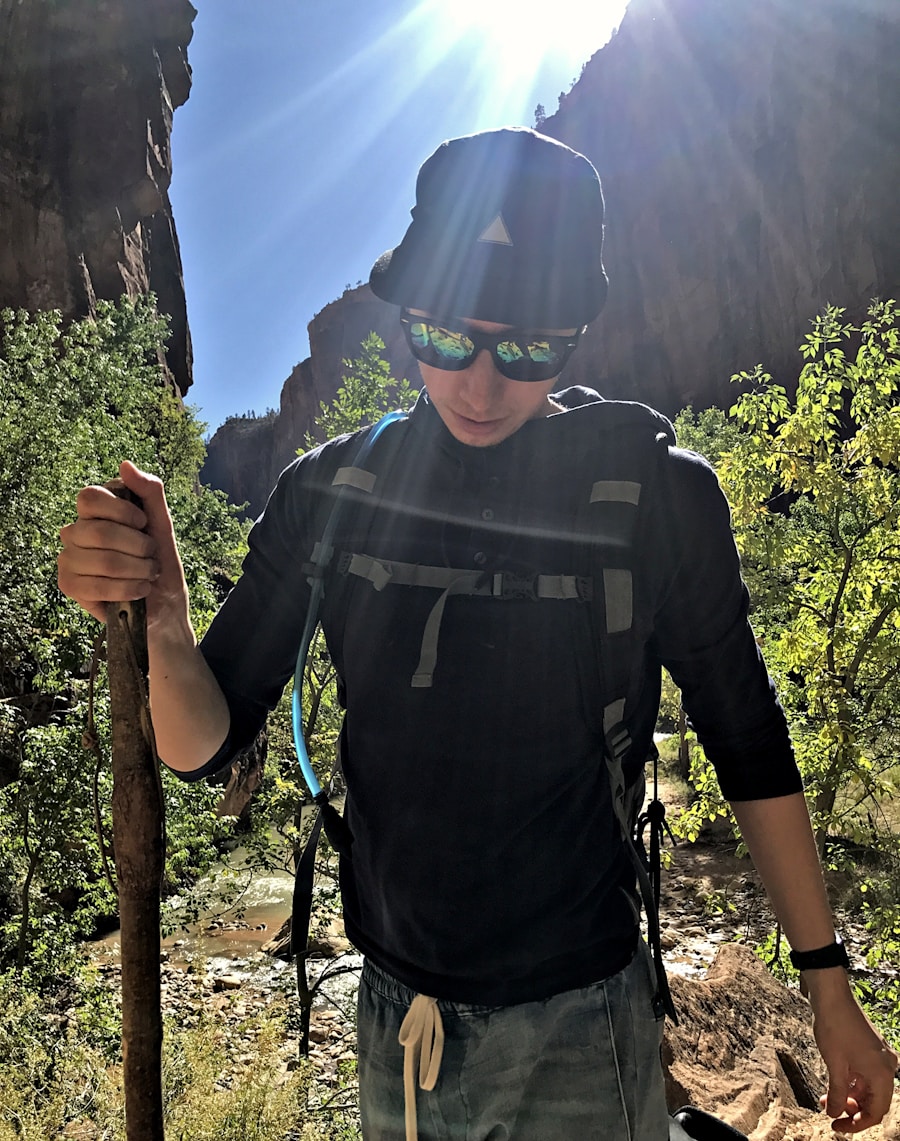Selecting the appropriate hiking boots is a critical step in preparing for any outdoor adventure. The right footwear can significantly enhance your comfort and performance on the trail, while the wrong choice can lead to blisters, discomfort, and even injury. When choosing hiking boots, it is essential to consider the type of terrain you will be traversing.
For instance, if you plan to hike on rocky or uneven surfaces, a boot with a stiffer sole and robust ankle support is advisable. This type of boot will provide the necessary stability and protection against sharp rocks and roots that can easily cause injury. Additionally, the fit of the boot is paramount.
A well-fitted boot should feel snug but not overly tight, allowing for some wiggle room for your toes. It is recommended to try on boots at the end of the day when your feet are slightly swollen, as this will give you a more accurate sense of how they will feel during a long hike. Furthermore, consider the material of the boot; leather offers durability and water resistance, while synthetic materials tend to be lighter and more breathable.
Ultimately, investing time in finding the right hiking boots tailored to your specific needs can make a significant difference in your overall hiking experience.
Key Takeaways
- Choose hiking boots that are waterproof, provide ankle support, and have a good tread for traction
- Layer clothing for comfort and protection, including a moisture-wicking base layer, insulating mid-layer, and weather-resistant outer layer
- Moisture-wicking clothing is important for staying dry and comfortable during hikes
- Select socks made of moisture-wicking materials and consider thickness and cushioning for added comfort
- Protect yourself from the sun with sunscreen, sunglasses, and a hat, and pack a lightweight rain jacket for unexpected weather changes
Layering for comfort and protection
Layering is a fundamental principle in outdoor clothing that allows hikers to adapt to changing weather conditions while maintaining comfort. The layering system typically consists of three main layers: the base layer, the insulating layer, and the outer layer. The base layer is designed to wick moisture away from the skin, keeping you dry and comfortable.
Fabrics such as merino wool or synthetic materials are excellent choices for this layer, as they provide breathability and quick-drying properties. The insulating layer serves to retain body heat, which is particularly important in cooler temperatures. Fleece jackets or down vests are popular options for this layer, as they offer warmth without adding excessive bulk.
Finally, the outer layer acts as a barrier against wind, rain, and other environmental elements. Waterproof and breathable jackets made from materials like Gore-Tex are ideal for this purpose, ensuring that you stay dry while allowing moisture from sweat to escape. By effectively layering your clothing, you can easily adjust to fluctuating temperatures and weather conditions throughout your hike.
The importance of moisture-wicking clothing

Moisture-wicking clothing plays a crucial role in enhancing comfort during outdoor activities such as hiking. When engaging in physical exertion, your body naturally produces sweat as a means of regulating temperature. However, if this moisture remains trapped against your skin, it can lead to discomfort, chafing, and even hypothermia in colder conditions.
Therefore, wearing moisture-wicking fabrics is essential for maintaining a comfortable body temperature and preventing excessive sweating. These specialized fabrics are designed to draw moisture away from the skin and disperse it across the surface of the material, where it can evaporate more easily. This process not only keeps you dry but also helps regulate your body temperature during strenuous activities.
For example, many outdoor brands offer shirts and base layers made from polyester or nylon blends that excel in moisture management. By incorporating moisture-wicking clothing into your hiking wardrobe, you can significantly enhance your overall experience on the trail.
Selecting the right socks
| Sock Material | Comfort Level | Moisture Wicking | Durability |
|---|---|---|---|
| Cotton | Medium | Low | Low |
| Wool | High | High | High |
| Synthetic | High | High | High |
The choice of socks may seem trivial compared to other hiking gear, but it can have a profound impact on your comfort and performance during a hike. Proper hiking socks are designed to provide cushioning, support, and moisture management, all of which are essential for preventing blisters and ensuring a pleasant experience on the trail. When selecting socks, consider materials that offer both breathability and moisture-wicking properties; merino wool is an excellent option due to its natural ability to regulate temperature and wick moisture away from the skin.
Additionally, pay attention to the thickness of the socks in relation to your hiking boots. Thicker socks may provide extra cushioning but can also lead to a tighter fit within your boots, potentially causing discomfort. Conversely, thinner socks may allow for more room but might not offer sufficient padding for long hikes.
It’s advisable to try on different sock thicknesses with your boots to find the perfect balance between comfort and fit. Investing in high-quality hiking socks can make a significant difference in preventing blisters and enhancing overall foot comfort during long treks.
Sun protection and appropriate headwear
When embarking on outdoor adventures, sun protection should be a top priority. Prolonged exposure to UV rays can lead to sunburns and increase the risk of skin cancer over time. Therefore, wearing appropriate clothing and accessories is essential for safeguarding your skin while enjoying nature.
Lightweight long-sleeve shirts made from UV-protective fabrics can shield your arms from harmful rays while keeping you cool in hot weather. In addition to clothing, headwear plays a vital role in sun protection. A wide-brimmed hat not only provides shade for your face and neck but also helps keep you cool by blocking direct sunlight.
Look for hats made from breathable materials that offer UPF (Ultraviolet Protection Factor) ratings for added protection. Sunglasses with UV protection are equally important; they shield your eyes from glare and harmful rays that can cause long-term damage. By prioritizing sun protection through clothing and accessories, you can enjoy your hiking experience without compromising your health.
Packing essential rain gear

Weather conditions can change rapidly in outdoor environments, making it crucial to be prepared for unexpected rain showers or storms. Packing essential rain gear is an integral part of any hiking trip, ensuring that you remain dry and comfortable even in inclement weather. A high-quality waterproof jacket is a must-have item; look for features such as adjustable hoods, ventilation zippers, and sealed seams to enhance functionality.
In addition to jackets, consider packing waterproof pants or gaiters that can protect your lower body from rain and mud.
These items are particularly useful when hiking through wet or marshy areas where water may splash up onto your legs. Furthermore, waterproof bags or dry sacks can help keep your gear protected from moisture while stored in your backpack.By being proactive about packing rain gear, you can mitigate the impact of adverse weather conditions on your hiking experience.
The benefits of convertible pants
Convertible pants have gained popularity among hikers due to their versatility and practicality in varying weather conditions. These pants typically feature zippers at the knees that allow them to be transformed into shorts quickly and easily. This adaptability makes them an excellent choice for hikes that may start cool in the morning but warm up significantly by midday.
The benefits of convertible pants extend beyond temperature regulation; they also provide convenience when transitioning between different environments or activities. For instance, if you encounter a stream or need to cool off during a hike, simply unzipping the legs allows for immediate relief without having to change entirely. Additionally, many convertible pants are designed with quick-drying materials that enhance comfort during wet conditions or after crossing streams.
By incorporating convertible pants into your hiking wardrobe, you gain flexibility and functionality that can enhance your overall outdoor experience.
Choosing the right backpack and accessories
Selecting the right backpack is essential for carrying all your gear comfortably during hikes of any length. When choosing a backpack, consider factors such as capacity, fit, and features tailored to your specific needs. Daypacks typically range from 15 to 30 liters in capacity and are ideal for short hikes or day trips, while larger backpacks designed for multi-day excursions can hold 50 liters or more.
A well-fitted backpack should sit comfortably on your back without causing strain or discomfort during movement. Look for adjustable straps and padded hip belts that distribute weight evenly across your body. Additionally, consider features such as hydration reservoirs or external pockets for easy access to essentials like water bottles or snacks while on the go.
Accessories also play a significant role in enhancing your hiking experience. Items such as trekking poles can provide stability on uneven terrain and reduce strain on your joints during steep descents. A good-quality first aid kit is another essential accessory that ensures you are prepared for minor injuries or emergencies while out on the trail.
By carefully selecting both your backpack and accessories based on your specific needs and preferences, you can create an efficient system that enhances comfort and convenience during your hikes.
When preparing for a hiking trip, it is important to dress appropriately for the outdoors. One helpful article that provides tips on how to dress when hiking can be found on TakeTravelInfo’s website. This article offers valuable advice on choosing the right clothing and footwear for a comfortable and safe hiking experience. For more travel-related articles and information, you can visit TakeTravelInfo.
Love travel? Join Our Facebook Community For More Tips.
FAQs
What should I wear when hiking?
When hiking, it’s important to wear moisture-wicking clothing that will keep you dry and comfortable. This includes a moisture-wicking base layer, a breathable and lightweight shirt, and quick-drying pants or shorts. It’s also important to wear sturdy and supportive hiking boots or shoes.
What type of fabric is best for hiking clothing?
The best fabric for hiking clothing is moisture-wicking and quick-drying. Look for synthetic materials such as polyester or nylon, or merino wool, which are all great at wicking away sweat and keeping you dry.
Should I wear layers when hiking?
Yes, it’s a good idea to dress in layers when hiking. This allows you to easily adjust your clothing to regulate your body temperature as you warm up or cool down during your hike. Start with a moisture-wicking base layer, add a lightweight insulating layer, and finish with a waterproof and windproof outer layer.
What type of footwear is best for hiking?
Sturdy and supportive hiking boots or shoes are best for hiking. Look for footwear with good traction, ankle support, and a comfortable fit. It’s important to break in your hiking footwear before hitting the trails to prevent blisters and discomfort.
What accessories should I bring when hiking?
When hiking, it’s important to bring a few key accessories, including a hat for sun protection, sunglasses, sunscreen, a brimmed hat, and a backpack to carry essentials such as water, snacks, a map, and a first aid kit. It’s also a good idea to bring along a lightweight and packable rain jacket in case of unexpected weather.
